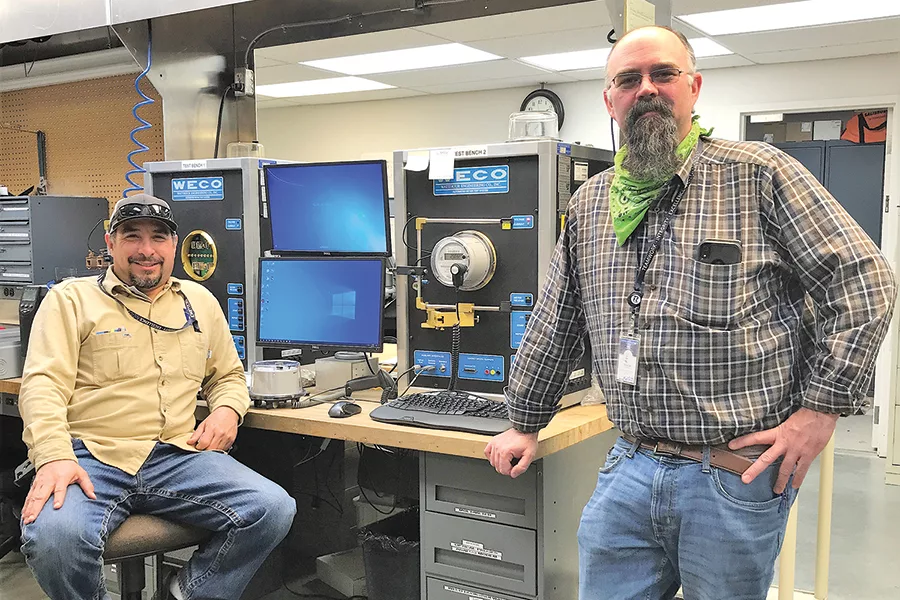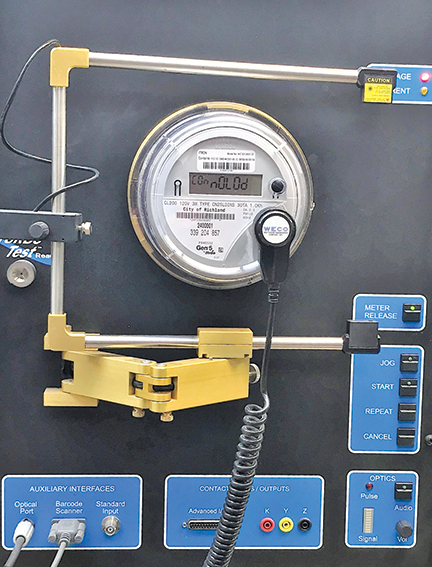
Home » Richland improves metering efficiency, renewable energy use
Richland improves metering efficiency, renewable energy use

December 14, 2021
Richland is preparing to launch final testing of a new utility metering system prior to its rollout in 2022, ending the need for dedicated meter readers to visit the 27,000 homes and businesses throughout the city.
Officials hope to have new electric and water meters installed in most locations by the end of next year. The city predicts its new $13 million Advanced Metering Infrastructure, or AMI, project to bring operational efficiency, a significant savings and improved customer service.
Richland Energy Services, or RES, will use certified contractors to install the wireless electric and water meters throughout most customer locations. A brief outage of either power or water is expected when one meter is removed and the other installed.
“The outage will last only as long as it takes to pull one meter and put the other one in,” said Sandi Edgemon, Richland’s business services manager.
Real-time data
Network devices will use radio frequency to transmit water or electric use recorded by the smart readers back to the city for interpretation of the data and billing.
“Customer service representatives will have near real-time information on power and water use and can troubleshoot with a customer,” Edgemon said. “Customers will also be able to monitor their use through a portal and make an informed decision, such as how to conserve electricity.”

Readings will be done in 15-minute intervals, which creates the “near real-time” ability to monitor. Additionally, Edgemon said if a customer is moving, terminating electricity happens at the “push of a button,” so the need to manually read the meter is no longer required.
Since the project was approved by city council in spring 2020, the city has prepared for the staff reduction expected by the elimination of six meter reader positions.
“During the past several years, RES has made available to the meter readers training and open positions within the city,” Edgemon said. “Several have successfully transitioned to other positions and careers.”
The city said AMI created opportunities for employees to develop and use new skills.
A limited number of manual meter readings will still need to be done for locations where a meter is in a basement or is unable to successfully transmit readings with a network device. Most customers will benefit from the added convenience of no longer needing to have a meter reader come onto their property.
Managing outages
AMI also is expected to improve the city’s outage management.
“Right now, if there’s an outage, or if something happens on the distribution line, we get information on our status system, but we also rely on people to call and say they’re out of power so we can better pinpoint the location,” Edgemon said. “Our status system shows what’s energized and what isn’t, but now we’ll be able to track it right down to the meter.”
A power outage will send an alert to the city’s operations center where crews can respond and restore service more quickly.
Additionally, the city expects to take proactive efforts if there’s an issue, like a broken pipe, that a customer might be unaware of.
“The AMI system will show a large increase in water consumption. When we see there is abnormal usage indicating a possible leak or break, we will contact the customer,” Edgemon said.
This could allow for much faster mitigation than a customer’s typical indication of a leak by receiving an unexpectedly high water bill.
Smart metering is already in use in Benton and Franklin counties for public utilities district customers.
Since first installing in 2009, a representative for Benton PUD said, “We have had good experience with this technology and experienced benefits from both a customer perspective and operational perspective.”
RES is installing network devices on streetlights and utility poles and will roll the system out citywide once all the testing confirms there are no “dead” spots for transmitting data.
Solar energy
Some of the power transmitted over Richland’s distribution lines includes solar-generated energy.
The city commissioned the state’s first utility-scale solar and battery project in Horn Rapids in November 2019.
It includes 11,400 solar panels paired with battery storage to provide enough electricity to power about 600 homes, and the battery storage capability to power about 150 homes for four hours.
RES buys the solar energy from Seattle-based Tucci Energy Services as part of a 25-year agreement.
The battery is operated by Energy Northwest, which developed the $6 million carbon-free project, and secured nearly half of the cost through a grant from the state’s Clean Energy Fund, managed by the Department of Commerce.
“We’re always watching for grants as they relate to new energy technology,” said Jared Knode, energy and professional services manager for Energy Northwest. “The Department of Commerce was looking for storage-related projects, and we saw it as an opportunity in our leadership role as a joint operating agency.”
The city invested the remainder for the 20-acre Horn Rapids Solar, Storage and Training, or HRSST, project after it was pitched as both a way to comply with the state’s demand for increasing use of clean energy through the Energy Independence Act, as well as its potential as an economic driver.
“The thing that made the project go was the realized economic benefit,” Edgemon said. “The unique thing about this project is that there’s a training center associated with it, so apprentice workers and licensed electricians can come and learn how to operate a photovoltaic system and can look at the battery and do some training on it. Because they would be coming in from other parts of the U.S., they’d be staying in hotels and dining in Richland.”
The predicted economic benefit calculated by the Pacific Northwest National Laboratory included 22 hospitality jobs indirectly created by the project, expected from an increased 3,600 hotel nights annually.
The training portion will be managed by a company based out of Sumner. At the time it was built, the HRSST was the largest project of its kind in the state. Now commissioned, PNNL will continue to assess the financial benefits of battery energy storage as a way to develop better battery designs and other tools to bring more “intermittents” onto the grid in a reliable, cost-effective manner.

Richland says it is on track to meet standards set by the Energy Independence Act which requires at least 3% of the energy taken come from renewable sources by 2026. The required percentage will increase in multi-year increments with an eventual goal of 15% clean energy.
The HRSST is considered beneficial to customers by creating a “more reliable and flexible source of energy.” The battery is charged by Richland’s distribution system during off-peak hours and in use during the peak times, saving money as well.
“(Energy Northwest’s) perspective is that we need to utilize every tool in the toolbox and storage of different types is going to play in energy use of the future with intermittents, so we need to be able capture the energy,” Knode said.
The large-scale project took more than five years to get off the ground but came to fruition with the assistance of the International Brotherhood of Electrical Workers Local 77, which owns and leases the land.
Unrelated to its partnership in the HRSST project, Richland recently came to an agreement with IBEW following a public dispute over its labor contract with city linemen.
“The collective bargaining agreement with IBEW is being routed for signatures. The city looks forward to a safe and productive relationship with IBEW benefitting employees and electric utility customers,” the city said.
IBEW had argued its pay was not competitive in the region and initiated a door-knocking campaign and other public outreach methods to bring awareness to their contract requests.
The city council approved a contract with IBEW in late September which takes effect until the end of 2023 and includes retroactive pay back to May 1, 2021. Richland described the terms as “competitive in the region.”
Local News Energy
KEYWORDS december 2021





